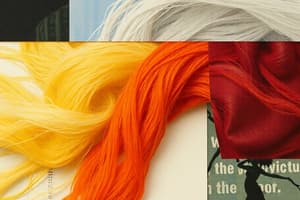Podcast
Questions and Answers
What are synthetic fibers?
What are synthetic fibers?
- Natural fibers found in nature
- Fibers that are only found in animals
- Manufactured fibers that are polymers made up of total chemical compounds (correct)
- Fibers that only come from plants
Which of the following are properties common to synthetic fibers? (Select all that apply)
Which of the following are properties common to synthetic fibers? (Select all that apply)
- Heat Sensitive (correct)
- Hydroscopic (correct)
- Excellent Abrasion Resistance (correct)
- Strong absorbency
What can be changed in synthetic fibers to improve performance?
What can be changed in synthetic fibers to improve performance?
Chemical formulation
At which stages can blending occur?
At which stages can blending occur?
When was nylon introduced?
When was nylon introduced?
What is a common use for nylon?
What is a common use for nylon?
What is polyester primarily made from?
What is polyester primarily made from?
What is a characteristic of polyester?
What is a characteristic of polyester?
What is olefin derived from?
What is olefin derived from?
What are common uses for olefin?
What are common uses for olefin?
Acrylic is highly flammable.
Acrylic is highly flammable.
Five 2-liter bottles can be turned into a _____?
Five 2-liter bottles can be turned into a _____?
What does the term 'chameleon fiber' refer to?
What does the term 'chameleon fiber' refer to?
What helps improve dye absorption in acrylic fibers?
What helps improve dye absorption in acrylic fibers?
Which synthetic fiber is derived from acrylonitrile?
Which synthetic fiber is derived from acrylonitrile?
Flashcards are hidden until you start studying
Study Notes
Synthetic Fibers
- Synthetic fibers are man-made polymers created from chemical compounds, categorized by their chemical composition.
Properties of Synthetic Fibers
- Heat-sensitive and thermoplastic, impacting their durability under heat.
- Uniformly structured under microscopic view; resembling glass rods with striations.
- Hydrophobic nature results in low absorbency and water resistance.
- Exhibits electrostatic properties, influencing cling and static buildup.
- Highly resistant to abrasion and chemicals, including resistance to insects and fungi.
- Tends to pill over time, affecting aesthetic appearance.
- Oleophilic, showing a strong affinity for oils and grease.
- Resilient and wrinkle-resistant, retaining shape after washing.
- Generally, average to low specific gravity, making them lightweight.
Engineering Synthetic Fibers
- Chemical formulations can be altered to enhance performance characteristics.
- Cross-section design can mimic natural fibers, examples include micro-fibers.
- Coloration occurs during fiber production, ensuring colorfastness.
- Various finishing agents can be integrated in the solution, like flame retardants and moth repellents.
- Fiber texture can be modified using crimping techniques.
- Fiber length varies from continuous filament to staple length by cutting strands.
Blending Processes
- Blending can happen at different stages: fiber, yarn, fabric, and finishing.
- Fiber stage includes creating bicomponent or matrix blends.
- Yarn stage allows twisting multiple fibers into a single yarn.
- Fabric stage can involve a mix of fibers in the warp and filling.
- Finished products may see application of metallic pigments or selective fiber burnouts.
Nylon
- Developed by Dupont in 1939 as a synthetic long-chain polyamide fiber.
- Melt-spun process utilized; forms include monofilament, multifilament, and staple fibers.
- Production involves polymerization of chemicals and water, followed by melting and extruding nylon chips.
Nylon Uses
- Commonly used in stockings, swimwear, bags, carpets, fishing lines, ropes, tents, and parachutes.
Care of Nylon
- Machine washable and tumble dried at low temperature; fabric softener recommended to mitigate static cling.
Polyester
- Introduced by Dupont in 1953 as a long-chain polymer from petroleum derivatives.
- Frequently texturized for bulk and volume; known as a chameleon fiber due to its versatility.
- Wrinkle-resistant and available in both filament and staple lengths with some odor retention issues.
Polyester Characteristics
- Low absorbency but resistant to stains and chemicals.
- Exhibits poor dyeability and heat conductivity but can be heat set for form stability.
Polyester Care
- Machine washable and tumble dried at low temp; immediate removal from dryer prevents wrinkles.
Polyester Uses
- Widely employed in wrinkle-free clothing, carpets, fiberfill stuffing, and various household fabrics.
Polar Fleece
- Made from recycled polyester, such as soda bottles; quantity requirements demonstrate sustainability.
- Examples include five bottles for a t-shirt and 200 bottles for sofa upholstery.
Acrylic
- Developed in the 1950s by Dupont and Monsanto, derived from acrylonitrile and various chemicals.
- Serves as a wool substitute but is highly flammable and generally produced in staple length.
Acrylic Uses
- Commonly found in ropes, shoelaces, coats, jackets, blazers, sweaters, and blankets.
Modacrylic
- A modified version of acrylic introduced in 1949, designed to be less flammable.
- Commonly used as a wool substitute, especially in fire-resistant applications.
Modacrylic Uses
- Utilized in fire resistant sleepwear, fake fur, wigs, carpets, and outdoor furniture textiles.
Olefin (Polypropylene)
- Developed by Hercules in 1961, consists of a long-chain polymer from propylene.
- Lightweight with moisture-wicking capabilities but challenging to dye due to low melting point.
Olefin (Polypropylene) Uses
- Found in industrial fabrics, moisture barriers, indoor/outdoor carpeting, and specialized garment linings.
Studying That Suits You
Use AI to generate personalized quizzes and flashcards to suit your learning preferences.




